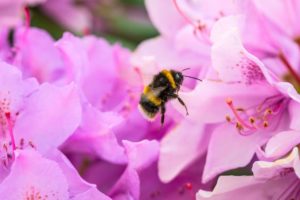For centuries, honey cultivated by beekeepers in the Black Sea region and the Himalayas has been used to treat a range of medical ailments from hypertension, diabetes, arthritis or even a sore throat. In small doses, the honey produced in this region is said to have a profound effect on the human body, but what is this effect, how is it produced and why does the honey sell for such a high price?

The bees in places such as Nepal are pollinating plants across the landscapes to produce honey which has a slight hallucinogenic effect on the human body. This honey is produced in areas where there are a high number of rhododendron plants. Rhododendrons contain a group of neurotoxic compounds called grayanotoxins, and so when bees pollinate these plants their resulting honey contains traces of grayanotoxin. Therefore, in places where there are widespread rhododendron plants, for example in the mountainous regions of Nepal, the bee’s honey contains much higher levels of this toxin. The resulting honey containing these toxins is reported to be redder in colour, with a slightly more bitter taste than the honey many of us know.
The most notable effect of the honey is euphoria, light-headedness, and dizziness – causing it to be called ‘mad’ honey by many. In low doses, the honey is said to have a slight hallucinogenic effect on the human body, however, if we were to consume it in high quantities the honey can cause serious complications including vomiting, loss of consciousness and even death. Therefore, in low doses, it has been used for centuries to treat a range of medical issues in countries across the world where this type of honey can be found. Although, as there is no way to control the amount of rhododendron pollen consumed by the bees, cultivators can never be sure of the potency of the resulting honey, so the effects can vary from season to season depending on the flowering of the rhododendron plants. Therefore, while the medical benefits of the honey cannot be guaranteed, the honey is, however, still used and sold across the world in very low doses for a variety of uses.
The ‘mad’ honey is known to be one of the most expensive types on the market, initially due to its hallucinogenic effect but also due to the extremely demanding conditions to retrieve the bee’s raw honey. Rhododendrons typically grow in high altitudes and so the hives of bees which produce the honey with high amounts of neurotoxic compounds are also found high in the mountains. Therefore, it is both difficult and dangerous to retrieve the honey, as hunters must climb down the side of the mountains amid swarms of bees to get to the hives. The hunting for the hallucinogenic honey extends back for centuries and so gathering and cultivating it has become a tradition. For many locals their communities have been sustained by agriculture for generations, however, many people have left their rural villages to work abroad, so hunting for honey remains a way that many villagers near these hives can reconnect with their ancestors.
Overall, the production and cultivation of ‘mad’ honey is a natural phenomenon which is both intriguing and dangerous. Whilst, the potential mood and pain effects are desired and effective for many, the retrieval and potential risks that it comes with makes it a dangerous game – but one that many locals are willing to take. Consequently, many tourists travel across the world to experience the effects of the honey, and many more seek it out to purchase it online. However, we can’t help but wonder whether the bees feel the hallucinogenic effects of the pollen too…







